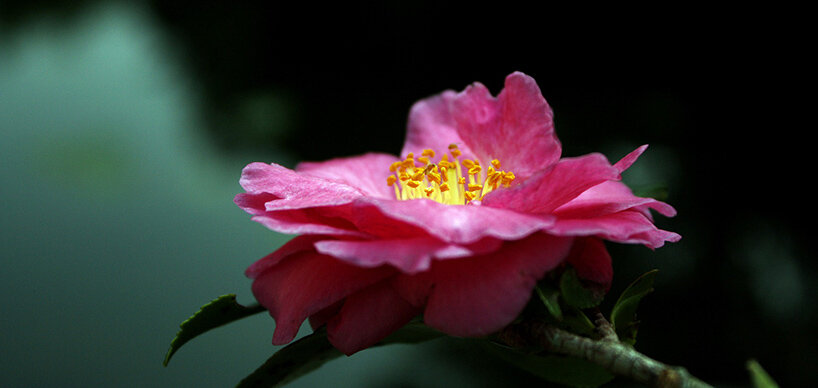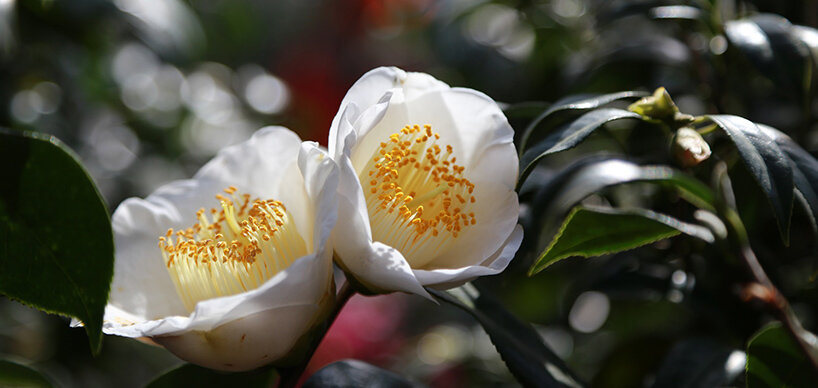Camellia sinensis: A Tea Plant with Special Effects

Everyone knows them, but mostly only from the cup: Camellia sinensis is the shrub that provides all types of tea, from black to green tea. We'll reveal how we've been harnessing the power of the tea plant for millennia and how you can even bring it into your home.
The tea bush from the Far East
Black and green, yellow and white tea, Oolong, and Pu-erh are all very different, yet they all come from one plant. An exotic shrub whose delicate leaves have long been a part of our everyday life: that's the tea plant Camellia sinensis, also known as Thea sinensis. In botanical terms, the genus Camellias belongs to the family of tea plants. Besides the shrub form, Camellia can also be found as a tree, which can grow up to nine meters high.
In China, the plant had already been cultivated and tea extracted from it a few centuries before our era. Green tea came from China to Japan, where there is still a highly developed culture around the tea ceremony. However, the hot beverage with caffeine and full of good health effects only arrived in Europe in the 17th century through the Dutch East India Company. The first destination for Asian tea in Germany was East Frisia - that's why black East Frisian tea is still popular here. According to studies, Germans cover three-quarters of their tea consumption with black tea.
The beautifully blooming camellia was already mentioned in Europe in the opera La Traviata. The plant is also cultivated here: there are now British and German tea plantations near Freiburg. However, most aromatic, dried leaves come from distant lands. There, they have ideal climatic conditions and space to grow. Where our tea comes from and how a delicious drink is made from a plant is the focus of the following.
Camellia sinensis in cup and garden
The "sinensis" in the name stands for "from China". However, the tea plant with its white-yellow flowers is also native to India and Southeast Asia. There are two important varieties depending on the distribution area: Camellia sinensis var sinensis, the "China shrub", which represents high-quality green tea, and Camellia sinensis var assamica (or Camellia assamica). The latter type with larger leaves is native to the Indian state of Assam, and black tea is mainly made from the "Assam shrub". We know tea from this part of the country as Assam tea. Other tea varieties from India include Ceylon and Darjeeling. Hybrid varieties between both camellia species are also possible.
Even today, China and India are among the most important tea-producing countries, but these camellias also grow in other East Asian and African countries, especially in Kenya. Not to mention Japan, which is known for particularly high-quality teas such as Sencha, Gyokuro, or Matcha tea.
The Camellia sinensis varieties differ not only in origin but also in health-promoting effects and taste. The Camellia sinensis sinensis tastes significantly milder compared to the Assam variety and is full of healthy ingredients such as vitamins, amino acids, and catechins. It makes sense that these effects would be preserved through gentle processing, as with green tea. On the other hand, the tea plant Camellia sinensis assamica from India has more tannins and caffeine. We provide more details about the positive effects of individual ingredients here.
Besides some other camellias, there is also a Camellia japonica, but no tea is made from it. Instead, the Japanese camellia with its beautiful white, red, or purple flowers adorns gardens and has even become the state flower of Alabama in the USA. In Dresden, there is also a particularly old camellia from Japan - a specimen that is over 200 years old. During the blooming season in winter, tens of thousands of flowers can be admired.

One plant - dozens of teas
But how do so many different tea varieties come from just one plant species? It's all about processing. While green tea, for example, is only roasted and dried, black tea is also fermented. In white tea, oxidation is prevented by heating. Let's take a detailed look at how individual tea varieties are created from the green leaves and buds of the camellia.
- Green Tea: The camellia leaves are initially steamed or roasted in a pan, then rolled and dried. Because the processing of green tea is very gentle, all the healthy ingredients are preserved. In the case of Japanese Matcha tea, it is not the whole leaf but the powder that is prepared. Different varieties of green tea differ based on cultivation and harvest time.
- Pu-erh Tea: After drying, the leaves are further fermented. Such tea can age for over 50 years before being consumed and has a very intense flavor.
- Yellow Tea: For this rare tea variety, the young buds and leaves of the camellia are steamed for an extended period after roasting, then roasted again at high temperature. This imparts a natural sweetness and a unique color resulting from slow oxidation.
- White Tea: Only the young, tender buds of the tea plant are used for white tea. They are initially left in the sun or in a room to wither, allowing slight oxidation. Instead of roasting, they are baked at 100 degrees and then rolled and dried. White tea is known for its particularly stimulating effect.
- Black Tea: The fresh leaves of the camellia wither before being crushed, destroying their structure for full oxidation. Only then are they rolled and dried.
- Oolong Tea: The production is similar to black tea, except that after withering, the leaves are only lightly shaken and then heated - either with steam or in a pan. This process allows them to undergo partial oxidation.

Care of your own Camellia sinensis
Can you really plant tea yourself? Absolutely! Small tea trees are available in various varieties for home gardens. Some varieties have a pleasant fragrance and are even winter-hardy, which is not a given for camellias.
If you want to cultivate a real tea plant, you just need to know some details about its care. It can thrive in the garden or as a houseplant. The camellia usually displays its fragrant flowers in the fall (August to October), but it can be grown throughout the year. Plant it at room temperature (around 20-25 degrees Celsius). After about a month, the seeds will germinate, and the mini-tree should be given some time to grow before repotting.
The Camellia sinensis needs light but does not tolerate direct sunlight. Therefore, the tea plant prefers a semi-shaded location. It likes high humidity and not too much heat - especially in summer, so regularly spray it with lime-free water. Too much wind is also not good for it. Moist, slightly acidic soil is suitable (optimal is rhododendron soil with a higher pH), and the Camellia sinensis does not require too much additional water. The camellia also appreciates organic fertilizer from spring to autumn. Wintering, especially for non-hardy varieties, is best done in the first few years in a sheltered place indoors.
Harvesting can begin in March if you want to try making real tea from local organic cultivation. The earlier the leaves are harvested, the more aroma the drink gets. It's best to pick the younger, fine upper shoots. Until mid-April, you get the "First Flush," between May and June, the "Second Flush." The autumn tea, the last harvest, is picked between October and November.
You can even eat the harvest directly: although they don't taste as good as freshly brewed, they are full of beneficial health compounds: polyphenols (secondary plant substances), antioxidant agents, vitamin C, catechins, and many other ingredients. Notably, green tea is considered a natural protection against cardiovascular diseases, diabetes, infections, high cholesterol, and other ailments. Proper preparation is essential, along with not overdosing. Besides these positive effects, the real tea plant delights the eyes and the nose - what more could you want?











-from-the-yakiyaki-grill-pan.jpg)




